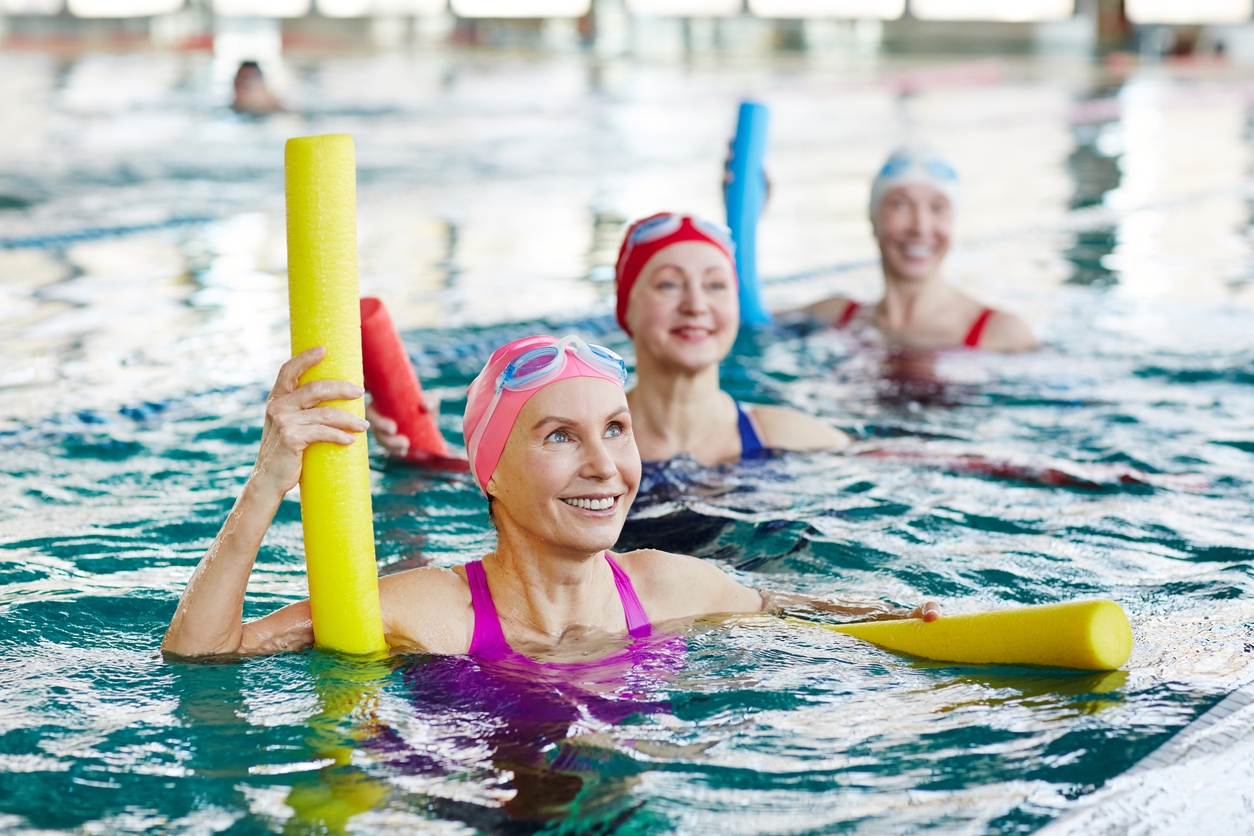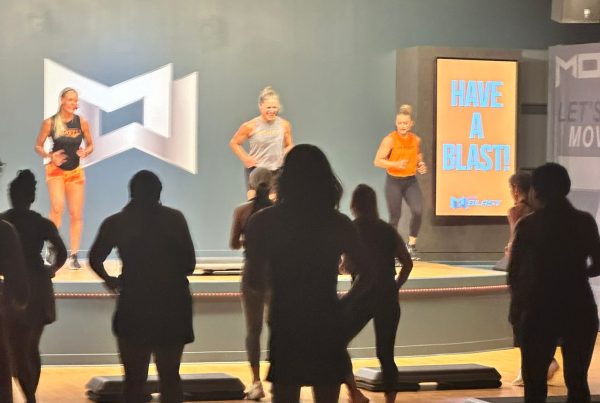Delivering a water exercise class to a group of mixed ages and abilities needn’t be a constant tug-of-war between opposing options, writes aqua instructor Marlee King.
From increasing muscle strength to alleviating pressure on the joints, the health benefits of aquatic exercise have long been known: it’s the quintessential ‘all-rounder’. It’s not surprising, therefore, that when it comes to group exercise, the pool is a suitable environment for people of all abilities and all ages. However, as a certified aquatics instructor, I am often presented with the challenge of creating a class plan that suits, and appeals to, all ages.
When preparing a class plan, instructors can easily get caught in a game of tug-of-war – being pulled between opposing options; ‘How do I make my class gentle yet challenging, trendy yet classic, new yet familiar?’ No one option is the clear winner, but there are several factors that you can consider when creating a class plan that’s suitable for all ages.
Implementing fitness variations and modifications
One of the core principles we learn when training to become instructors is to offer fitness variations or modifications. In aquatic fitness, it would be surprising to find a certified instructor who is not familiar with the hand variations (i.e., slice, fist, scoop, flat palm). There are a plethora of articles offering advice on fitness modifications, so rather than elaborate on those here, let’s reiterate some useful advice:
✔️ Implement progressions. Instruct different levels of the same exercise to accommodate participants with different fitness levels. You may introduce the progressions over the course of the song routine or over multiple classes.
✔️ A simple routine doesn’t mean an easy routine. It’s helpful to include a couple of simple routines that encourage muscle load. This is a nice compromise between those who like things simple and those who want a good workout.
✔️ Learn to read your participants’ faces. Look for signs of boredom, overexertion, confusion and, of course, excitement. This will keep you on your toes and will tell you when you need to mix things up.
Music moves us all!
Music is our greatest tool in creating a class plan that appeals to all ages. Nietzsche was alleged to have said ‘We listen to music with our muscles.’ This is true, and often without our knowledge or volition. Take a moment to note how your body reacts to music. When music plays, do you nod your head? Tap your feet? Do you sing along or even change your facial expressions? You’ll find that your body does indeed react in some way to music, regardless of what age you are. The belief that certain genres are too old/too trendy or too fast/too slow for certain ages is simply not true. Most songs are useable when paired with appropriate routines and taught correctly. So why not put a variety of genres in your playlist or consider using songs with various beats per minute? If you’re looking for a sure thing, use songs that are familiar and that everyone can sing along to.
There are some songs and artists that most people seem to know, as if they transcend age. Using hit tracks from (or cover versions of) artists like Madonna, Elvis, Queen and Beyoncé can strike a chord with twentysomethings to eighty-somethings. Songs from movie soundtracks such as Dirty Dancing or The Greatest Showman are also worth exploring. If you have a selective preference for music, try to find a happy compromise between your musical tastes and those of your participants by using a mixture of music genres or remixes of popular songs.
Don’t make assumptions about participants
Imagine for a moment that you are standing on the poolside in front of a new class comprising seniors, mothers, teenage girls and male athletes. What would you do? Do you have a class plan to accommodate the wide-ranging needs and interests of this diverse group? If your answer is yes, then the next question is, what do you think their needs and interests are? How have you come to this conclusion?
Most instructors who have long-term classes come to learn about participants’ abilities, likes and dislikes, but what about new classes or unfamiliar groups? One method to guide your class planning is to use the group’s demographics to roughly ascertain preferences for music style and intensity. I recently used this to guide my song choice for a group of school students. As such, I used more recent and energetic songs. But demographics is just a guide and never a hard and fast rule.
Regarding music style, don’t underestimate younger participants’ capacity to appreciate the classics. I have literally used classical music with teenagers, with much success. Equally, don’t assume that older participants just want popular genres from the 50s, 60s and 70s. I learnt this music lesson when I started a new Aqua Zumba® class. I was told that most of my participants would be over 65, so I put rock’n’roll, swing, disco and Motown songs onto the class playlist in place of genres including EDM, reggaeton and merengue. The class was fine, if not overly exciting. So, over time, I introduced a variety of genres. Today, my class enjoys music from across the decades and from all over the world. The most requested song? Fireball by Pitbull.
Just as with musical tastes, you shouldn’t make assumptions about ability based on age. You might find that your oldest participant is your strongest, so don’t be afraid to shake things up. Include a variety of music, a range of exercises from gentle to challenging, and even try using interval music formats such as Tabata. Your participants might just love it.
Be an entertainer
The saying goes that ‘Time flies when you’re having fun’ and it’s true. Research shows that individuals in a high state of boredom tend to perceive time as moving slower, compared to those in a low state of boredom. This appears to occur when individuals perceive their task as a chore. No one likes chores and everyone has the capacity to get bored. Therefore, your class needs to be fun and enjoyable. But how do you achieve this? Music and dynamic routines are of course essential, but the answer actually lies in your capacity to entertain your participants while they’re working out.
When you keep participants entertained, they don’t have time to look at the clock, be self-conscious or think about how much effort a certain move is.
Being entertaining during class requires creativity. It might sound strange, but in my introduction I sometimes describe the upcoming class like a dinner menu: an entrée with some heavy beats, a big hearty main, and a cool-down with some yummy stretches for dessert. This makes the class sound like an unmissable treat. Don’t say things like, ‘And I have some 50s music for our older participants’. Make it clear that every single moment in your class is for everyone to enjoy.
Don’t be afraid to do things like pick up an imaginary microphone and encourage your participants to sing along. Not everyone will sing, but it might humour them. Gestures like this engage your participants and keep them open to trying a range of different things.
It is worth noting that you need to also sell your class to your participants. If you don’t believe that your participants will like your class plan, then they probably won’t. We humans are quite attuned to others’ emotions and can sense an instructor’s lack of confidence in their programme. This affects the participants’ perception of the class because if you don’t like it, then why should they? Simply being enthusiastic and energetic will help to convince your participants that coming to your class was an excellent choice, because enthusiasm is contagious.
A class for all, by all
Make it clear that everyone is a crucial part of your class, regardless of age and ability. There are very simple ways to achieve this. The first is to be adaptable. For example, some classes may not like a certain song, even if it’s a hit in another class. Therefore, it’s important to note what doesn’t work, and implement alternatives when necessary.
Finally, and perhaps most importantly, when it comes to creating a class that is a hit with all ages and abilities, make sure that you are approachable to all. Encourage participants to make song requests, talk to participants before and after class, introduce yourself to newcomers; learn their names and make eye contact during class. These seemingly minor actions reinforce to participants that no matter their age or ability, this is the class for them.
THE QUICK READ
✔️ Learn to read participants’ faces and adapt your class accordingly
✔️ Instruct different levels of the same exercise to accommodate participants with different fitness levels
✔️ Use a mixture of music genres and modern remixes of older, familiar songs
✔️ Don’t underestimate the capacity of younger participants to appreciate the classics, and older participants to enjoy newer tracks
✔️ Entertain your class and make it clear that every single moment is for everyone to enjoy.
This feature was originally published by fitnessnetwork.com.au and has been recreated with permission.
Author Bio:

MARLEE KING is a certified aquatic fitness and licensed Zumba® instructor. Marlee holds a PhD in health psychology and is an academic at Western Sydney University. Her experience in fitness, combined with her interest in the mind-body connection, gives her a deep understanding of her participants.







